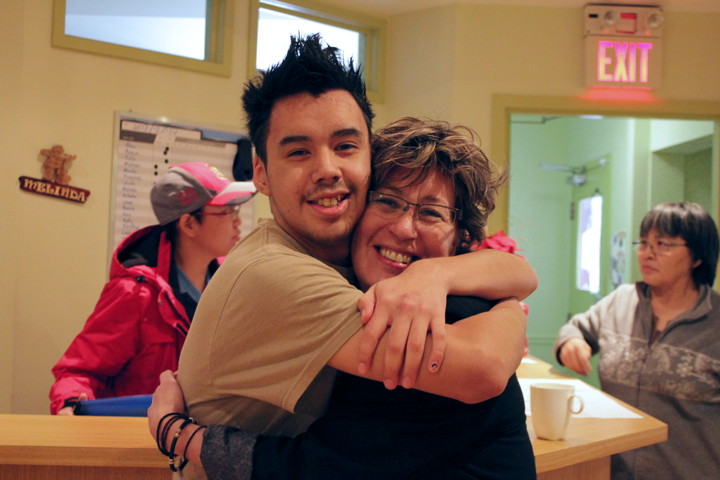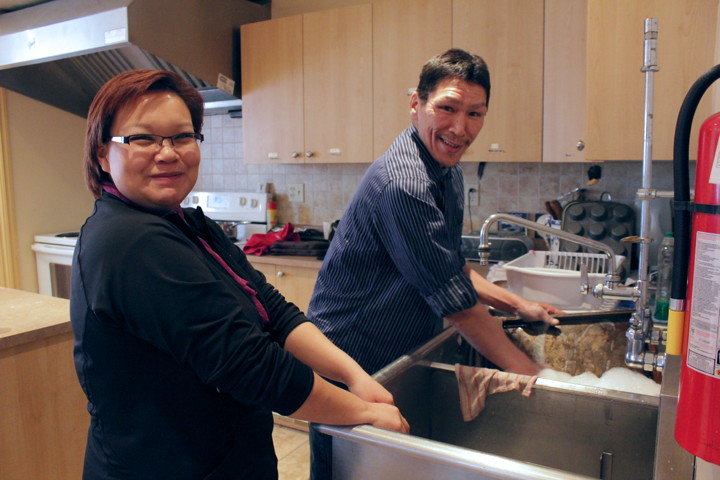Inuit treatment residents hopeful, wary, about the holidays
“The depth of trauma among Inuit is breathtaking”

The morning group therapy session at Mamisarvik Healing Centre in Ottawa begins with a prayer. On this day, clients discuss forgiveness, and their plans for coping in a healthy way once they leave the centre. (PHOTO BY LISA GREGOIRE)

Counsellor and Indian Residential School co-ordinator Meeka Papatsie hugs one of the young clients who has just come through the six-week trauma and addiction program at Mamisarvik Healing Centre in Ottawa. (PHOTO BY LISA GREGOIRE)
OTTAWA — Nine men and two women, ranging in age from mid-20s to over 50, sit in a circle in an Ottawa basement surrounded by homemade posters about anger, depression, anxiety, alcoholism, child sexual abuse and guilt.
They are talking about forgiveness.
“I think it’s a very important part of my recovery. As long as I don’t let things go, I will have resentments. Therefore, I learn how to forgive myself,” says one woman.
“It’s so complicated,” she goes on. “I didn’t see that I was hurt. I thought it was my fault… I have childhood traumas but I have to take care of myself.”
Another man, a little older, is less generous.
“I’m having a hard time forgiving some stuff right now. It makes me really angry,” he says. Tears fall down his face and a younger man hands him a box of tissues.
“I have three cousins dead, brothers dead, because they were physically and sexually abused. I tried to forgive those people who did that but it’s so hard… I thought sexual abuse was part of life. It’s not part of life.”
These men and women are taking part in group therapy in their final week of residential addictions and trauma treatment at the Mamisarvik centre in Ottawa, one of only two Inuit-specific treatment centres in Canada. The only other centre is a small one in Kuujjuaq called Isuarsivik.
Some 500 Inuit have undergone treatment here in the 10 years since Mamisarvik began operating under the umbrella of Tungasuvvingat Inuit, the Ottawa-based service organization for Inuit. While the centre does address addiction, it is more focused on treating trauma and other root causes of addiction.
But the centre will undergo a massive restructuring in 2014 now that the federal government has discontinued the Aboriginal Healing Foundation fund which gave the centre $806,000 annually — about half their budget.
Ben Bridgstock, the centre’s new director and former head of a Salvation Army addiction program in Ottawa, said Mamisarvik isn’t the only organization suffering under the loss of AHF funding.
But he said the centre is unique because it serves an Inuit clientele in a culturally-sensitive way and in Inuktitut.
“We’re the only one doing what we’re doing for this particular segment of the population and it would be a tragedy if that were somehow jeopardized or diluted because we don’t have the money,” Bridgstock said. “I don’t know why the policy is the way it is.”
Mamisarvik gets the remainder of its funding from the Government of Nunavut and Corrections Canada for client referrals.
After this current session ends Dec. 18, Mamisarvik will move from a schedule that saw four, six-week client intakes annually to a continuous intake system so that beds can be filled year round.
Mamisarvik is also going through an accreditation process and training upgrade to better market itself to other jurisdictions and hopefully broaden its client base.
But ultimately, Mamisarvik may have to cut extras such as elders and others who come in for cultural programs and retreats into nature where counsellors say the deepest disclosures often occur.
“In the long run, I’m confident it will be successful and it will enhance the program because we will have to be more fiscally responsible, more businesslike,” said Bridgstock. “But for the next little while, it will be very difficult.”
On Dec. 18, the current group of clients, who have spent six weeks untangling years of destructive behaviour to get to the root causes of their pain, will graduate from the program — people abused or neglected by family members, husbands and wives, priests and other so-called leaders.
And then they’ll go home, to southern cities, and northern towns, to holiday celebrations that will probably include some of the people, memories and triggers that sent them here in the first place.
The group therapy session on Dec. 6 is an attempt to remind clients that they have many healthy coping options, from taking walks and volunteering their time to identifying sober, supportive friends they can call and visit.
Counsellor Natasha Aaluk, who is helping to lead the session, says clients must practice coping now, and have a plan in place, so they’re not caught unprepared when anxiety, fear, panic or anger overtake them after they leave Mamisarvik.
“This is something I learned from Rick,” says one man, referring to counsellor Rick Mayoh. “One thing you can’t take away from me is how I react to what you do to me. I can choose to believe and act the way I choose. No one can make me feel a certain way.”
Mayoh, who is in the room, whispers a victorious, “Yes,” pleased that his teachings are getting through.
Mayoh, who started working at Mamisarvik in 2004, is very discouraged by the collapse in federal funding.
“I just go over it and over it in my head. This is one of the brightest jewels in the Inuit world, in a barren landscape of resources. How can they let this happen?” Mayoh asks.
The timing is particularly bad given the latest revelations in the trial of disgraced priest Eric Dejaeger, convicted of the sexual abuse of children in Baker Lake and facing dozens of new charges from his time in Igloolik about 30 years ago.
Bridgstock said studies show the average sexual predator has 200 victims. Those victims learn inappropriate sexual behaviour and often victimize others, to the point where the abuse becomes widespread within a small population.
“So there’s a massive need for treatment, to break that cycle and that repetition of abuse and re-victimization,” Bridgstock said.
From what Mayoh has seen over the past decade, he agrees. “The depth of trauma among Inuit is breathtaking,” he said.
“They come with tremendous courage and trust and they say, ‘Help me.’ One reason it works is because this is a safe place,” he says, gesturing to walls covered with Inuit art and Inuktitut chatter from the kitchen. “They can say, ‘I’m safe here. I can take a risk and I’ll be OK.”
Mamisarvik is a crucial training ground for Inuit social workers and counsellors, he added, but there are other unique aspects to Mamisarvik as well.
The centre holds daily co-ed group therapy sessions, a rarity in counselling circles that perhaps reflects the need Inuit feel to stick together and support each other, Mayoh said.
Through co-ed counselling, women who have suffered spousal abuse can see that men are suffering too. And men can see the depth of the pain they are causing women.
However, Mamisarvik does hold weekly gender-specific group therapy and on this day, counsellor Meeka Papatsie is doing something called “self-care” with the two women clients.
This involves soaking feet, facial masks and nail painting.
“We do intensive programming Monday to Friday. They take stuff from the inside and put it outside. But you have to take care of the outside too,” said Papatsie, herself a recovered addict.
“When you are suffering, you don’t care what you look like. I never used to look in the mirror because I didn’t want to see what was looking back at me.”
Before the session starts, one of the male clients says self-care sounds more fun than the session he’s about to attend and asks if he can join the women. He’s only half joking.
The two female clients smear their faces with coloured creams and explain what the program has meant to them.
“I’m going to have to face my wounds,” says Lalli Betsy Annanack. “My anxiety is mostly gone. I make better decisions now. Every mistake is a lesson.”
Colleen Ulayuruluk, 25, feels like she still has time to live a better, happier life.
“I’m so grateful to be here. I never knew about any of this before — trauma, addiction,” she says. “I realized I had to forgive others back home, and I had to forgive myself for hurting others. Now that I have all this forgiveness, I feel so lifted.”
We contacted Health Canada media relations to ask whether the department planned on replacing the AHF funding or whether there were other federal funding options for Mamisarvik.
Health Canada called to clarify the question but has not yet responded with information.

Colleen Ulayuruluk and Danny Napachee in the Mamisarvik kitchen. It was Napachee’s turn to clean up after lunch Dec. 6. Residents who are physically able share cleaning duties through the week and cooking duties as well on the weekend, when there is no staff cook. (PHOTO BY LISA GREGOIRE)





(0) Comments